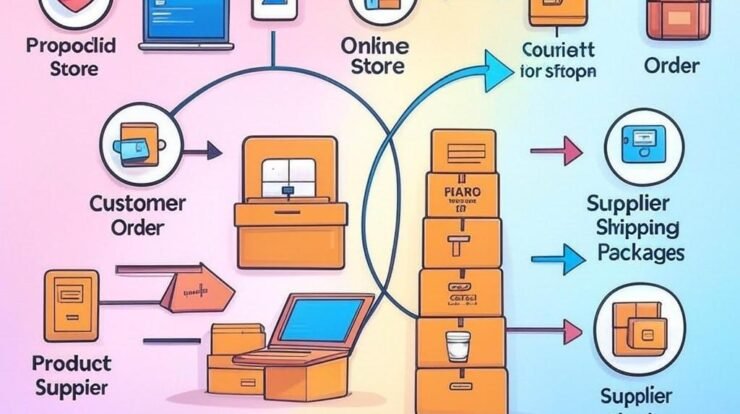Starting an Etsy shop with no money might sound like a pipe dream, but it’s entirely possible with the right approach, a bit of creativity, and a lot of hustle. As someone who’s navigated the world of e-commerce and helped countless entrepreneurs launch their online businesses, I’m here to share a detailed, step-by-step guide on how to start an Etsy shop without spending a dime upfront. This guide is packed with practical tips, insider knowledge, and proven strategies to help you turn your passion into a thriving Etsy business, even if your budget is zero.
Whether you’re a crafty maker, a digital artist, or someone with a knack for sourcing unique items, Etsy offers a platform to showcase your creations to a global audience. But let’s be real—starting any business can feel daunting, especially when funds are tight. The good news? You don’t need a big bank account to get started. By leveraging free tools, smart strategies, and Etsy’s built-in features, you can launch a shop that’s professional, profitable, and poised for success. Let’s dive into the nitty-gritty of how to start an Etsy shop with no money, optimized for success from day one.
Why Start an Etsy Shop with No Money?

Etsy is a powerhouse for small-scale entrepreneurs. With over 96 million active buyers in 2024, the platform connects sellers with a massive audience looking for handmade, vintage, and unique goods. The beauty of Etsy is its low barrier to entry—you don’t need a fancy website, a physical storefront, or a big marketing budget to get noticed. But starting with no money requires a mindset shift. It’s about working smarter, not harder, and using every free resource at your disposal.
The goal here is to build a shop that’s sustainable and scalable without upfront costs. This means focusing on low- or no-cost inventory, free marketing channels, and Etsy’s built-in tools to create a professional presence. By following the steps below, you’ll learn how to start an Etsy shop for free, avoid common pitfalls, and set yourself up for long-term success.
Step 1: Find Your Niche Without Spending a Penny
The first step to starting an Etsy shop with no money is identifying a niche that aligns with your skills, passions, and market demand. A niche is your shop’s unique selling proposition—what makes you stand out in a crowded marketplace. The key is to choose something you can create or source without upfront costs.
Brainstorm Low-Cost Product Ideas
- Handmade Goods: If you’re crafty, consider products you can make using materials you already own. For example, if you have yarn, fabric scraps, or basic art supplies, you could create knitted scarves, upcycled clothing, or hand-drawn prints. Look around your home—what can you repurpose?
- Digital Products: Digital downloads are a goldmine for zero-cost startups. Think printable planners, wall art, knitting patterns, or even digital stickers for apps like GoodNotes. Creating digital products requires only your time and skills, with no material costs.
- Print-on-Demand (POD): POD services like Printful or Printify allow you to design products (like t-shirts, mugs, or posters) and list them on Etsy without paying upfront. You only pay the supplier after a sale is made, making it a perfect no-money option.
- Vintage or Resale Items: If you have vintage clothing, books, or collectibles gathering dust, these can be listed as long as they’re at least 20 years old (Etsy’s rule for vintage items). Check your attic, basement, or local thrift stores for free or low-cost finds.
Research Market Demand
Use Etsy’s search bar to explore what’s trending. Type in keywords related to your skills (e.g., “crochet patterns” or “vintage jewelry”) and see what pops up. Pay attention to listings with high reviews or “bestseller” badges—these indicate demand. You can also use free tools like Google Trends or social media platforms like Pinterest to spot popular niches without spending a dime.
Pro Tip: Validate Your Idea
Before committing, test your idea by sharing it on free platforms like Instagram or Reddit. Post a photo of your product (or a mockup for digital items) and ask for feedback. This helps you gauge interest without investing money.
Read more: AIBot Studio review – Insights and Analysis
Step 2: Set Up Your Etsy Shop for Free
Etsy makes it easy to start a shop without upfront costs. The platform charges $0.20 per listing, but you’re only billed after your shop is live and you’ve made sales (or after four months if the listing doesn’t sell). Here’s how to set up your shop for free:
Create an Etsy Account
Go to Etsy.com and sign up for a free account. You’ll need an email address, a password, and a name for your shop. Choose a name that’s memorable, reflects your niche, and is easy to spell. For example, if you’re selling digital planners, something like “PlanSavvyStudio” works better than a generic name like “Shop123.”
Build Your Shop Profile
Your shop profile is your digital storefront, so make it shine. Use a free photo-editing tool like Canva to create a logo and banner. If you’re not selling physical products yet, create mockups of your digital or POD items to give your shop a polished look. Write a compelling “About” section that tells your story—why you started, what inspires you, and what makes your products special. This builds trust with buyers.
List Your First Product
You don’t need to pay to list your first product upfront. Create a listing with clear, high-quality photos (more on that later) and a detailed description. Use keywords like “handmade,” “digital download,” or “vintage” to make your listing searchable. Set a competitive price by checking similar products on Etsy—aim to be in the middle range to attract buyers without undervaluing your work.
Step 3: Source or Create Inventory Without Spending Money
Inventory is often the biggest hurdle for cash-strapped entrepreneurs, but there are plenty of ways to stock your shop without spending a cent.
For Handmade Products
Look at what you already have. Got a stash of beads? Make jewelry. Have old magazines? Create collage art. The key is to use materials you already own or can source for free (think recycling bins, thrift stores, or even nature—pinecones and shells can become decor).
For Digital Products
Digital products are the ultimate no-cost option. Use free software like Canva, GIMP, or Google Docs to create printables, templates, or designs. For example:
- Planners and Templates: Design weekly planners, budget trackers, or habit trackers.
- Art Prints: Create digital illustrations or typography art.
- Etsy Shop Resources: Sell Canva templates for other Etsy sellers to use for their listings.
For Print-on-Demand
Sign up for a free account with a POD provider like Printful. Design your products using their free mockup tools, then list them on Etsy. You only pay the supplier after a customer buys, so there’s no upfront cost. Focus on designs that resonate with your niche, like funny quotes for t-shirts or minimalist art for posters.
For Vintage Items
Check your home for items that qualify as vintage (20+ years old). Old books, records, or clothing can be listed. If you don’t have anything, ask friends or family if they’re willing to donate items you can sell. You can also visit free community swap events or curbside pickups to source inventory.
Read more: Unveiling the Power of WebHub AI – A Comprehensive Review
Step 4: Take Stunning Photos on a Budget
Great photos are non-negotiable on Etsy—buyers rely on visuals to make decisions. You don’t need a fancy camera to take professional-looking photos. Here’s how to do it for free:
- Use Your Smartphone: Most modern smartphones have excellent cameras. Shoot in natural light (near a window) to avoid harsh shadows.
- Create a Simple Backdrop: Use a white sheet, a piece of cardboard, or even a clean tabletop as your backdrop. Neutral backgrounds make your products pop.
- Edit Photos for Free: Apps like Snapseed or Canva’s photo editor let you adjust brightness, contrast, and saturation to make your photos look pro.
- Stage Your Products: For physical items, add props like plants or books (items you already own) to create a lifestyle vibe. For digital products, create mockups showing your design in use (e.g., a printable on a desk).
Step 5: Optimize Your Listings for Search
To get your products in front of buyers, you need to master Etsy’s search algorithm. This is where keyword optimization comes in. Think of it as making your listings easy for shoppers to find when they search terms like “how to start an Etsy shop with no money” or “affordable handmade gifts.”
Use Descriptive Titles
Write clear, keyword-rich titles. For example, instead of “Necklace,” use “Handmade Beaded Boho Necklace for Women.” Include specific details like materials, style, or use case (e.g., “wedding gift” or “digital planner for students”).
Fill Out All Listing Fields
Etsy lets you add tags, categories, and attributes to your listings. Use all 13 available tags with relevant keywords (e.g., “digital download,” “printable art,” “vintage dress”). Be specific but broad enough to capture related searches.
Write Detailed Descriptions
Your description should answer every question a buyer might have. Include:
- What the product is and how it’s used.
- Why it’s unique (e.g., “designed with eco-friendly materials”).
- Keywords naturally woven in (e.g., “perfect for anyone learning how to start an Etsy shop on a budget”).
Read more: How to Make Money in Minutes for Free: My Personal Journey and Proven Tips
Step 6: Market Your Shop for Free

Marketing is where many new sellers think they need to spend money, but there are plenty of free ways to promote your Etsy shop.
Leverage Social Media
Create free accounts on Instagram, Pinterest, and TikTok. Share behind-the-scenes content, like how you make your products or design your digital files. Use hashtags like #EtsyShop, #HandmadeWithLove, or #DigitalDownloads to reach a wider audience. Post consistently—once a day is a good start.
Join Online Communities
Engage in free platforms like Reddit (subreddits like r/Etsy or r/smallbusiness) or Facebook groups for Etsy sellers. Share your expertise, answer questions, and subtly promote your shop when allowed. Building relationships in these communities can drive traffic to your listings.
Use Etsy’s Built-In Tools
Etsy offers free promotional tools like the “Share & Save” program, where you get a discount on fees if you share your listings on social media. You can also run sales or offer discounts to attract first-time buyers without spending money.
Step 7: Manage Finances Wisely
Starting with no money means you need to be strategic about cash flow. Etsy’s fees ($0.20 per listing, 6.5% transaction fee, and payment processing fees) are only charged after you make a sale, so you’re not out of pocket upfront. Here’s how to stay financially savvy:
- Price for Profit: Factor in Etsy’s fees when setting prices. For example, if your product costs $10 to make (or $0 for digital products), add a markup to cover fees and ensure profit. A good rule of thumb is to price at 2-3x your costs.
- Reinvest Earnings: Use your first sales to cover listing fees or invest in low-cost materials to expand your inventory.
- Track Expenses: Use a free spreadsheet (like Google Sheets) to track income and expenses. This helps you stay organized and avoid surprises.
Step 8: Scale Your Shop Without Breaking the Bank
Once your shop starts generating sales, you can scale without spending much. Here’s how:
- Add More Listings: The more products you list, the more chances you have to be found. Use profits to cover new listing fees.
- Expand Your Niche: If you’re selling digital planners, add related products like stickers or habit trackers. For handmade goods, offer variations (e.g., different colors or sizes).
- Improve Your Photos: As you earn, invest time in refining your photography skills or upgrading your setup with free or low-cost props.
Common Mistakes to Avoid
Starting an Etsy shop with no money is doable, but there are pitfalls to watch out for:
- Poor Photos: Blurry or dark photos turn buyers away. Always prioritize quality visuals.
- Generic Listings: Vague titles or descriptions hurt your searchability. Be specific and keyword-focused.
- Ignoring Customer Service: Respond to messages promptly and handle issues professionally to build trust and earn reviews.
- Giving Up Too Soon: Sales may take time. Keep tweaking your listings, posting on social media, and engaging with buyers.
Final Thoughts: Your Etsy Journey Starts Now
Starting an Etsy shop with no money is not only possible—it’s a fantastic way to turn your creativity into a sustainable business. By focusing on low-cost or no-cost inventory, leveraging free tools, and optimizing your listings for search, you can build a shop that attracts buyers and generates income. The key is to start small, stay consistent, and reinvest your earnings to grow.
Whether you’re creating digital downloads, repurposing materials, or diving into print-on-demand, the strategies above will help you launch a successful Etsy shop without spending a dime. Take it one step at a time, experiment with what works, and don’t be afraid to pivot if needed. Your Etsy shop is your chance to share your unique creations with the world—so get started today and watch your business grow!





